Daily Analysis 08/04/2024
Latest Economic and Fundamental Insights
The dollar index has fallen by about 13% against a basket of major currencies from its 20-year high last year, reaching a 15-month low.
Ebbing inflation in the United States is accelerating the dollar’s decline, and risky assets around the world are expected to benefit.
US data released on Wednesday showed that inflation slowed more than expected, accelerating the dollar’s decline and reinforcing expectations that the Federal Reserve is on the verge of ending its rate hike cycle.
The dollar’s decline is a boon for some US companies because a weaker currency makes exports more competitive abroad and makes it cheaper for multinationals to repatriate foreign earnings.
The metal is on track for a new record high, up 15% over the past two months, also driven by strong buying from central banks and demand from momentum funds.
A foreign exchange analyst at Credit Suisse said, “For markets, the decline in the dollar and the reason behind it, which is the decline in inflation, makes things easier, especially for assets outside the United States.”
US Treasury yields have fallen in recent days, making the US currency less attractive and boosting a number of other currencies.
Middle East tensions spook markets
Karl, a senior market analyst at Corpay, said, “The sound you hear is the breaking of technical levels in the foreign exchange markets… The dollar is heading towards the levels that prevailed before the Fed started raising interest rates, and we see risk-sensitive currencies rising.”
Wednesday will be a very important day in terms of data, as the core consumer price index for the month and year will be released, and markets are looking forward to the minutes of the Federal Open Market Committee meeting, and let’s not forget the Canadian interest rate decision.
On Thursday, unemployment claims rates will be released in the afternoon, along with the monthly and annual producer price index, which will have a major impact on market movements.
Gold prices managed to break new records during trading today, Friday, and reached a new record during trading, despite the strength of the dollar after the release of positive US labor market data that beat market expectations, which may affect future US monetary policy decisions.
Crude oil prices saw stable movements during early trading on Friday, but quickly managed to achieve clear gains as the week’s trading came to a close, for the seventh consecutive session, but with the opening of Monday, oil fell with the decline in tensions in the Middle East, with Brent crude trading at levels of $89.00 and West Texas Intermediate crude at levels of $85.00.
Bitcoin price is trying to make a recovery wave above the $72,000 resistance level. BTC needs to break above the $70,000 resistance level to continue its upward movement in the near term.
Smart technical reports
How they work
A likely scenario is proposed for today, and the probability of this scenario being achieved, according to technical analysis, may be between 60% and 75%.
If the first scenario fails, the probability of the second scenario being achieved will be between 60% and 75% certain.
The first scenario fails when the price reaches the level of the alternative scenario condition, and the alternative scenario is immediately activated and the prediction from the first scenario is cancelled.
These reports are not considered a substitute for the trader’s decision, but rather they are a tool to assist the follower in making his own decisions, as a reference based on the origins of classical technical analysis.
GOLD
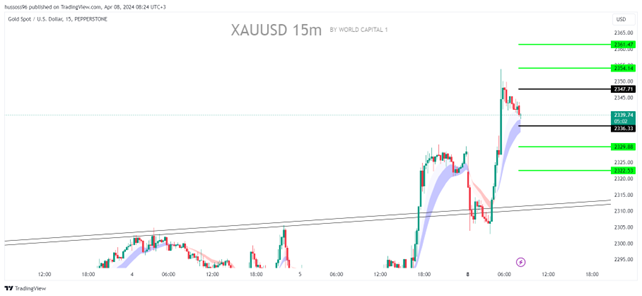
General trend: bullish
Time interval: half an hour (30 minutes)
Current price: 2339.74
The first scenario: Buy gold at a break and hold above 2347.71, with a target price of 2354.14 and 2361.47. Alternative scenario: Sell gold at a break and hold below 2336.33, with a price target of 2329.88 and then 2322.53.
Comment: Trading above supports and averages suggests an upward trend
CRUDE OIL
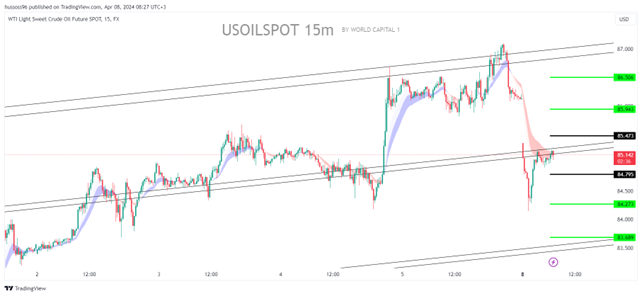
Trend: bullish
Time interval: half an hour (30 minutes)
Current price: $85.14 per barrel
The first scenario: Buying oil at a break and holding steady by closing the candle at the highest level at $85.47, targeting a price of $85.94, then 86.50. Alternative scenario: Selling oil at a break of $84.79, targeting a price of $84.27, then 83.68.
Comment: Trading above supports and averages suggests an upward trend
EURUSD
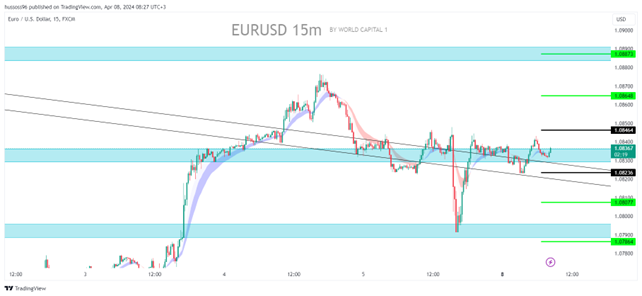
General trend: – Bearish
Time interval: half an hour (30 minutes)
Current price: 1.08367
The first scenario: sell the euro/dollar at a break of 1.08236, targeting a price of 1.08077, then 1.07864. Alternative scenario: buy the euro/dollar at a break of 1.08464, targeting a price of 1.08648, then 1.08873.
Comment: Trading below resistances and averages suggests a decline
GBPUSD
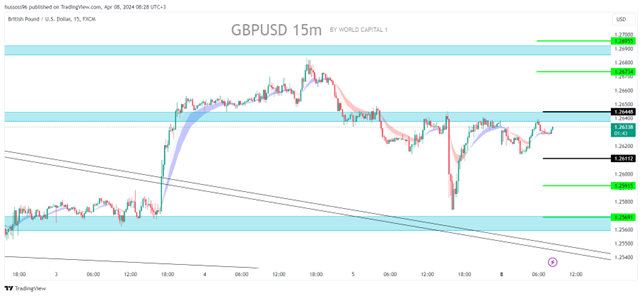
Trend: bullish
Time interval: half an hour (30 minutes)
Current price: 1.26336
The first scenario: Buying the pound dollar at a break and holding at the highest level of 1.26448, targeting a price of 1.26734 then 1.26955 Alternative scenario: selling the pound dollar at a break and holding steady at a close below 1.26112, targeting a price of 1.25915 then 1.25691
Comment: Trading above supports and averages suggests an upward trend 1.25915
NAS100
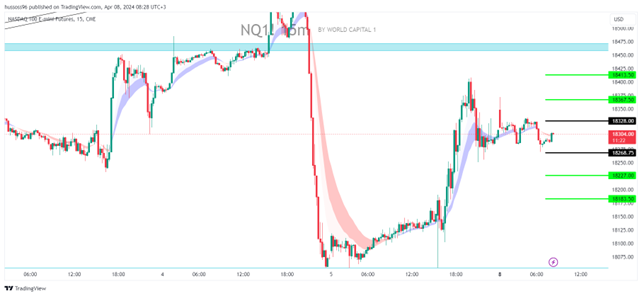
Trend: down
Time interval: half an hour (30 minutes)
Current price: 18304
The first scenario: Selling the Nasdaq at a break and holding steady with a close below 18268, targeting the price of 18227 then 18183. The alternative scenario: Buying the Nasdaq at a break and holding steady with a close above 18328, targeting the price of 18367 then 18413.
Comment: Trading below resistances and averages suggests a decline
Economic Calendar
(Times are in GMT+3)
There is no important data released today.
Fundamental Analysis
The dollar’s decline for the first time since 1998 has its own risks, one of which is a potential increase in inflation in the United States, which increases the stakes for more monetary tightening.
In terms of monetary policy, the decline in the dollar may be a relief for some countries because it removes the urgent need to support their currencies.
One of these countries is Japan. The dollar has fallen three percent against the yen this week and is on track for its biggest weekly decline against the Japanese currency since January.
The US labor market data showed mixed performance in February, with the economy adding about 275,000 jobs. However, the unemployment rate rose to 3.9%, and wages also recorded weak growth of only 0.1% on a monthly basis, below market expectations of 0.2% growth during the same period. This data had a somewhat negative impact on the dollar’s movements against other currencies, as it reinforced expectations that the Fed may be close to cutting rates as the labor market calms.
The decline in the dollar has its own risks, one of which is a potential increase in inflation in the United States, which increases the stakes for more monetary tightening and a decline in many anti-dollar trades that have flourished this year.
Despite the slowdown in inflation, the US economy has remained strong compared to other countries. Few experts believe that the Fed will cut rates anytime soon, which could limit the dollar’s decline in the near term.
Gold prices rose sharply as geopolitical tensions in the Middle East escalated. The commander-in-chief of the Iranian Revolutionary Guard, General Hossein Salami, told the crowd gathered in Tehran that the “enemy’s (Israeli) actions” against the Islamic Republic will not go unanswered, and that the men of Iran will punish the Zionist entity. These statements have raised concerns about the escalation of tensions in the Middle East and the outbreak of a major regional war.
It is worth noting that crude oil trading was under strong upward pressure due to rising concerns about the disruption of oil supplies to the markets. The NATO military alliance said on Thursday that the ongoing Ukrainian drone attacks on refineries in Russia may have disrupted more than 15% of Russian energy, affecting the country’s fuel production.
Risk Disclaimer
Any information/articles/materials/content provided by WRC1 or displayed on its website is intended to be used solely for educational purposes only and does not constitute investment advice or a consultation on how the client should trade.
Although WRC1 has taken care to ensure that the content of such information is accurate, - it cannot be held responsible for any omission/error/miscalculation and cannot guarantee the accuracy of any material or any information contained herein.
Therefore, any reliance you place on such material is strictly at your own risk. Please note that the responsibility for using or relying on such material rests with the client and WRC1 accepts no liability for any loss or damage, including without limitation, any loss of profit which may arise directly or indirectly from the use of or reliance on such information.
Risk Warning: FX/CFDs are complex instruments and carry a high risk of losing money quickly due to leverage. You should consider whether you understand how FX/CFDs work and whether you can afford to take the high risk of losing your money.
You should make sure that, depending on your country of residence, you are allowed to trade with WRC1 products. Please ensure that you are familiar with the company’s risk disclosure.
 en
en